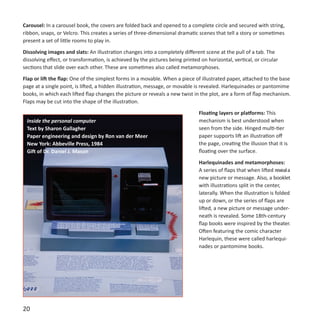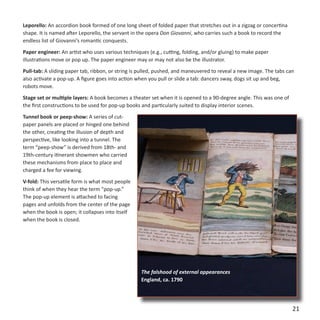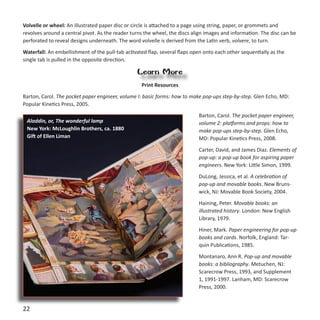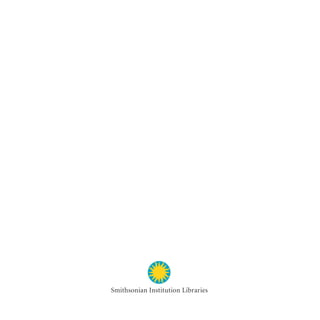This document provides an overview of the Smithsonian exhibition "Paper Engineering: Fold, Pull, Pop & Turn" which showcases over 50 examples of pop-up and movable books spanning 500 years. It discusses the origins of movable book mechanisms in medieval times and how they were used to calculate data and communicate information. In the 16th century, advances in printing and scientific knowledge led to more elaborate pop-up books being created to visually demonstrate complex systems. More recently, pop-up books have been used to teach children in an interactive way and to bring the natural world to life through intricate paper engineering. The exhibition aims to allow visitors to experience these rare works as the creators originally intended.



![4
have been delighting and engaging readers and non-readers,
young and old alike, for nearly 800 years. Using inventive ways to fold paper and create move-
ment, pop-up artists and paper engineers transform the printed page from two-dimensional
forms to three-dimensional experiences.
Movables have mechanisms such as flaps, pull tabs, and wheels (volvelles) that cause movement
on the page surface. Pop-ups employ various folding devices that cause figures to lift, pop up,
rise and unfold, or unfold and extend when a page is opened. Despite changes in technologies,
materials, and mechanisms, contemporary books, like their predecessors, are still assembled
by hand and share some of the same
construction principles. And although
we may associate pop-ups and mov-
able books with children, adults were
the original audience for what was
anything but child’s play.
presents more than 50
examples of action-packed construc-
tions and inspired works of art span-
ning 500 years.
We hope exhibition visitors will expe-
rience these rarely seen treasures as
their creators intended—as remark-
able works that calculate, educate,
entertain, and amaze.
Pop-up and movable books
Paper Engineering: Fold, Pull,
Pop & Turn
Moderne technik [Modern technology]
Hans Blucher (1867-1927)
Leipzig and Vienna: Bibliographisches Institut, 1912](https://image.slidesharecdn.com/fpptbrochure-131005215440-phpapp02/85/Fppt-brochure-4-320.jpg)

![6
The invention and expanded use of movable press type, which began in the 1450s, coupled
with the growth of scientific knowledge published in the centuries that followed, resulted in the
creation of some of the most magnificent volvelles of all time. Among these, with beautifully
embellished wheels to calculate astrological and astronomical data, are Peter Apian’s Astronomi-
cum caesareum (1540), Johann Schöner’s Opera mathematica (1550), and Leonhard Thurneys-
ser’s Dess menchen circkel und lauff (1575-1583).
In more modern times, wheels, placed within texts or as stand-alone objects, have been used to
count calories, match paint colors, identify bird species, score contract bridge, and present fun
facts about American presidents.
How Better to Explain
From the 16th century onward, the
publishing of illustrated works grew
rapidly. Advances in printing made
books more accessible, and schol-
ars demanded up-to-date recorded
knowledge. Movable and pop-up
books were used to demonstrate
visually complex systems, particularly
relating to medicine, mathematics,
and technology. How better to explain
the intricate layering and position of
organs in the human body than by
creating a series of hinged flaps that
Enhancing Discovery
and Learning
Astronomicum caesareum [The emperor’s astronomy]
Peter Apian
Ingolstadt, Germany, 1540
On loan from Mr. and Mrs. Robert Gordon and the Adler
Planetarium](https://image.slidesharecdn.com/fpptbrochure-131005215440-phpapp02/85/Fppt-brochure-6-320.jpg)
![7
when opened reveal, for example, the chest cavity, as in David Pelham’s The human body (1983),
or the multiple valves and muscles of the heart in René Descartes’ De homine [On Man] (1662).
To illustrate the theorems and proofs of the Greek mathematician Euclid, three-dimensional
cubes, squares, and triangles rise from the page in The Elements of geometrie . . . (1570) [page
5]. The complex parts of cars, steam-powered locomotives, ships, and other machines seen in
Moderne technik (1912) [page 4] are revealed and explained layer by detailed layer. Ron Van der
Meer’s Inside the personal computer (1984) [page 20] provides a basic introduction to the PC,
with a three-dimensional prototype that pops up off the page. And in Observations on the theory
and practice of landscape gardening
(1803), English landscape designer Sir
Humphry Repton cleverly uses flaps to
create “before” and “after” views that
help prospective clients visualize the
transformation of their gardens.
Teaching the Basics
Movable and pop-up books teach
in clever ways, making the learning
experience more effective, interactive,
and memorable. In late-18th-century
England and America, an educated
middle-class population emerged
from the Industrial Revolution. They
recognized the importance of child-
hood and had disposable income
to purchase books to educate their
De homine [On man]
René Descartes
Leiden, Netherlands: Petrus Leffen & Franciscus Moyardus, 1662](https://image.slidesharecdn.com/fpptbrochure-131005215440-phpapp02/85/Fppt-brochure-7-320.jpg)

![9
when they present a chance to interact by pulling tabs, turning wheels, and becoming part of the
action. For young readers, visuals can easily illustrate abstract concepts such as the opposites
of night and day, summer and winter. Contrasting images are revealed when a tab is pulled in
Dean’s new book of dissolving views (1860). Following a story read aloud while illustrations move
and lift off the page makes learning enjoyable and interactive. The nutcracker: a pop-up (1992),
with paper engineering by Paul Wilgress, and the pop-up version of Eric Carle’s The honeybee
and the robber (1981) incorporate movable and pop-up mechanisms within the narrative.
Visualizing the World Around Us
Movable and pop-up books also help
us document, explore, and experience
the wonders of our built and natural
environment. In paper engineer
Ib Penick’s Those fabulous flying
machines (1985) [page 19] intricately
drawn and constructed pop-up
images of aircraft seem to hover over
the page. In Vic Duppa-Whyte’s The
space shuttle action book (1983),
we can visualize the structure and
detailed parts of each vessel. The
natural world comes alive when a
larger-than-life, yet anatomically
precise image of a bee unfolds to
360 degrees in David Hawcock’s Bee
(1994). Readers encounter the stages
Dean’s new book of dissolving views
London: Dean & Son, 1860
Gift of Margery Masinter](https://image.slidesharecdn.com/fpptbrochure-131005215440-phpapp02/85/Fppt-brochure-9-320.jpg)
![10
of development of dinosaurs in the National Geographic Society’s action-packed Creatures of
long ago: dinosaurs (1988); experience the color, movement, and depth of the jungle in Amazing
monkeys (1985); and explore the sights and sounds of birds in their natural habitats in Birdscapes
(2008).
The early accordion book Thames tunnel (1843), recent pop-up surveys of the works of archi-
tects Frank Lloyd Wright (2002) and Frank Gehry (2007), and Keith Moseley’s La maison victo-
rienne . . . (1999) all document the dynamic forms associated with buildings, monuments, and
bridges. Other movables and pop-ups, such as Peter and Wendy see the New York World’s Fair
(1963), commemorate historic events,
while Pat Paris’ The first Noel: a holi-
day pop-up book (1998) and others
celebrate seasonal festivities.
Movable and pop-up books provide
new perspectives and enhance our
experience of everyday activities and
surroundings. Munich artist Lothar
Meggendorfer was the creator of
early complex pull-tab mechanisms
that caused multiple movements
within one scene. In his Neue lebende
bilder (1880), a butcher chops meat,
a girl draws water from a well, a man
teaches his dog a new trick, and two
women wash clothes after pull-tabs
initiate the action. Meggendorfer also
created colorful stage-like panoramas
Neue lebende bilder: ein ziehbilderbuch [New living pictures:
a pull-picture-book]
Illustrations and paper engineering by Lothar Meggendorfer
Munich: Verlag von Braun & Schneider, ca. 1880](https://image.slidesharecdn.com/fpptbrochure-131005215440-phpapp02/85/Fppt-brochure-10-320.jpg)
![11
in Im stadtpark [The city park] (1887) and illustrated his books with whimsical yet familiar char-
acters that greatly appealed to young readers. We get a bird’s-eye view of the inside of a 1950s
service station when the carousel book Garage (1950) is fully unfolded. As the central page of
Bruce Foster’s Wow!: The pop-up book of sports (2009) is opened, we’re suddenly at center court
with the net lifting off the surface and a tennis ball zooming directly at us.
Stories that feature children relating to the world are the focus of many movable and pop-up
books. Children play together in Raphael Tuck & Sons’ Jolly companions (1896) and participate in
the adventures of the Jolly Jump-Ups family, a series of stage-set pop-ups created by Geraldine
Clyne (1930s-1960s). Ernest Nister,
a Nuremberg publisher and innova-
tor of pop-up and movable mecha-
nisms, regularly features well-dressed
Victorian children in stories like his
Circling surprises (1901), a revolving
wheel slat book. A visit to the zoo
becomes an exciting adventure in
Nister’s The model menagerie (1895),
when caged animals magically lift into
three-dimensional forms as each page
is turned. Children enjoy a trip to the
circus in paper engineer Julian Wehr’s
Animated circus book (1943), in which
his pull-tab system allows circus ani-
mals and performers to move across a
page in all directions.
The model menagerie: with natural history stories
L.L. Weedon, Evelyn Fletcher, and Ernest Nister
New York: E.P. Dutton, ca. 1895
Gift of Dr. Daniel J. Mason](https://image.slidesharecdn.com/fpptbrochure-131005215440-phpapp02/85/Fppt-brochure-11-320.jpg)
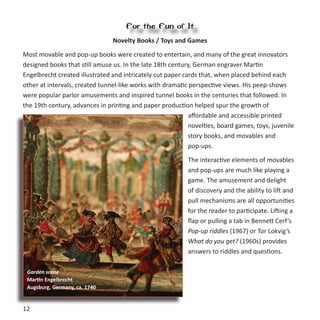
![13
You can discover all five senses in Tony Sarg’s Surprise book (1941), and find the hidden numbers
in Paul Zelinsky’s Knick-knack paddywack! (2002) nursery rhyme book.
Fairy Tales
A longstanding tradition and popular theme of movables and pop-ups is the re-telling of fairy
tales and fables. As early as the 1850s, London publisher Dean & Son, considered one of the
pioneering innovators of books with movable parts such as the pull tab and the dissolving image,
developed movable editions of Aladdin, Cinderella, and Little Red Riding Hood. In Dean’s Cin-
derella, or, The little glass slipper (1850), die-cut images lift from the surface of the page when a
ribbon is pulled.
The McLoughlin Brothers, a New York-
based publisher of board games and
some of America’s earliest pop-up
books, retell the story of Aladdin. In
their pantomime book, Aladdin, or,
The wonderful lamp (1880) [page 22],
movable characters appear in a stage-
like setting. From 1932-1935, The Blue
Ribbon Publishing Company of New
York produced a series of colorful,
large-type fairy tale pop-up books
under the direction of paper engineer
Harold B. Lentz. These included The
“pop-up” Mother Goose, Jack the gi-
ant killer, Puss in Boots, and Sleeping
Beauty. The Pop-up Pinocchio (1932)
Cinderella, or, The little glass slipper
London: Dean & Son, ca. 1850
Gift of Dr. Daniel J. Mason](https://image.slidesharecdn.com/fpptbrochure-131005215440-phpapp02/85/Fppt-brochure-13-320.jpg)
![14
[page 3], an abbreviated version of the traditional Italian folk story, featured several distinctive
v-fold and box and cylinder constructions: one with Pinocchio reading, another of his house, and
yet another of a large whale.
Mario Zampini, an Italian illustrator and stage designer, uses a series of theatrical sets in a carou-
sel book to recreate the story of Ali Baba and the 40 thieves [Ali Baba e i 40 ladroni] (1950). New
interpretations of fairy tales and traditional folk stories remain popular and continue to inspire
paper engineers and pop-up artists today.
Adventure and Fantasy Stories
Adventure and fantasy stories for chil-
dren were first published in the 19th
century. Many of the most popular of
these were issued in several subse-
quent editions and later in pop-up
and/or movable versions—most
notably Peter Rabbit, Winnie-the-
Pooh, and Charles Kingsley’s 1920
novel Water-babies. S. Louis Giraud,
publications manager for London’s
Daily Express, in collaboration with
inventor Theodore Brown, created a
true “pop-up” book that automatically
unfolds to become a three-dimension-
al free-standing figure viewable from
all sides.
Ali Baba e i 40 ladroni [Ali Baba and the 40 thieves]
Mario Zampini and Raimondo Centurione
Milan: Hoepli editore, ca. 1950
Gift of Roma and David Korris](https://image.slidesharecdn.com/fpptbrochure-131005215440-phpapp02/85/Fppt-brochure-14-320.jpg)
![15
These new pop-up constructions appeared in Giraud’s adventure story Animal life in fact, fancy
and fun (1930).
In the 1950s-1960s, Vojtěch Kubašta, an Austrian-born paper engineer and illustrator working in
Czechoslovakia, created a series of pop-up adventure and fantasy stories combining bold folk art-
style imagery, distinctive colors, and innovative cut and folded paper styles. Some of his large-
scale constructions of this period include Marco Polo (1962), The tournament (1950s), and Ricky
the Rabbit (1961). Later and contemporary pop-up fantasy and adventure books include James
Roger Diaz’s Alice’s adventures in Wonderland (1980), Jan Pieńkowski’s Robot (1981), Robert
Sabuda’s The wonderful wizard of Oz
(2000), and Sam Ita’s Moby Dick: a
pop-up book (2007).
Movable and pop-up books have also
reflected the influence of popular
culture and the mass media. In the
1930s, The Blue Ribbon Publishing
Company and Pleasure Books
introduced a series of small, colorful,
comics-inspired pop-up books that
included Dick Tracy, capture of Boris
Arson (1935) and Terry and the
Pirates in ”Shipwrecked” (1935) [page
16]. Later pop-ups featured characters
from television series such as
Hopalong Cassidy lends a helping hand
(1950) and Sesame Street (1970s-
Animal life in fact, fancy, and fun
Edited and produced by S. Louis Giraud
England: Daily Sketch & Sunday Graphic, ca. 1930
Gift of Dr. Daniel J. Mason](https://image.slidesharecdn.com/fpptbrochure-131005215440-phpapp02/85/Fppt-brochure-15-320.jpg)
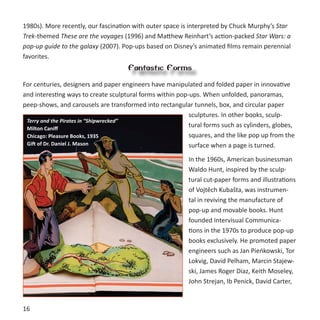

![18
Marion Bataille’s ABC-3D (2008) [page 17] and David Carter’s One red dot (2004) [cover].
Today’s imaginative paper engineers continue to explore and to innovate new ways to fold paper,
devise complex pull tabs that create movement, design intricate three-dimensional pop-up
forms, and use cut paper, string, and other mechanisms to make figures magically twist and turn.
The possibilities seem endless. Each year hundreds of action-packed, beautifully crafted works
pop up to inspire, awe, educate, and heighten our love and enjoyment of books.
Whether early or contemporary, movables and pop-ups dramatically offer children and adults
the opportunity to discover and experience the joy of books in delightful and remarkable ways.
ABC–3D
Marion Bataille
New York: Roaring Brook Press, 2008
Gift of Elizabeth Broman](https://image.slidesharecdn.com/fpptbrochure-131005215440-phpapp02/85/Fppt-brochure-18-320.jpg)

